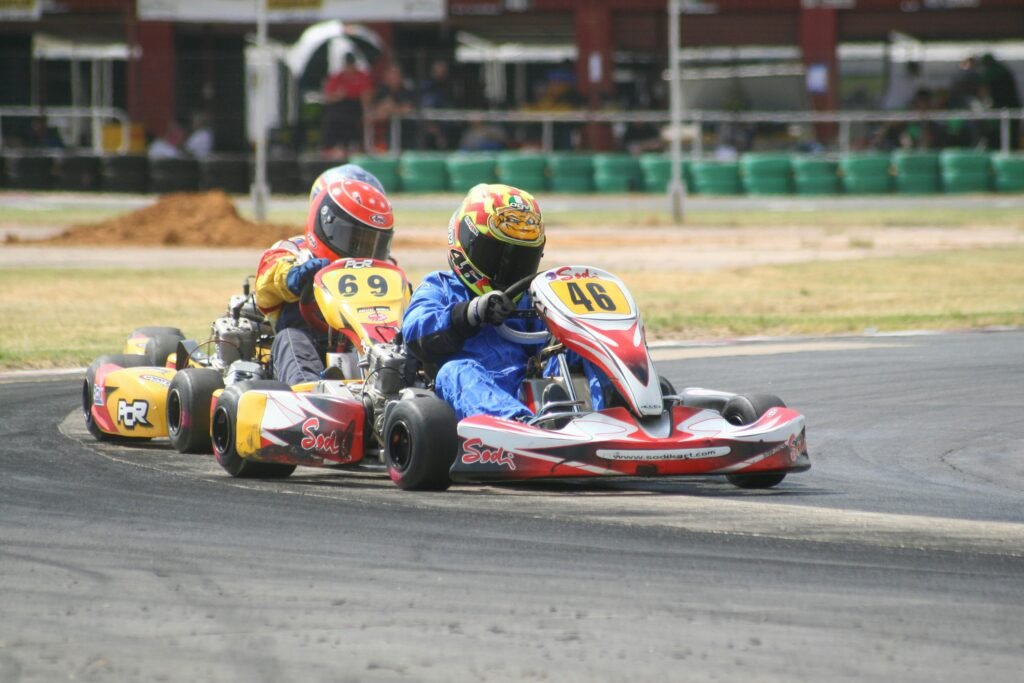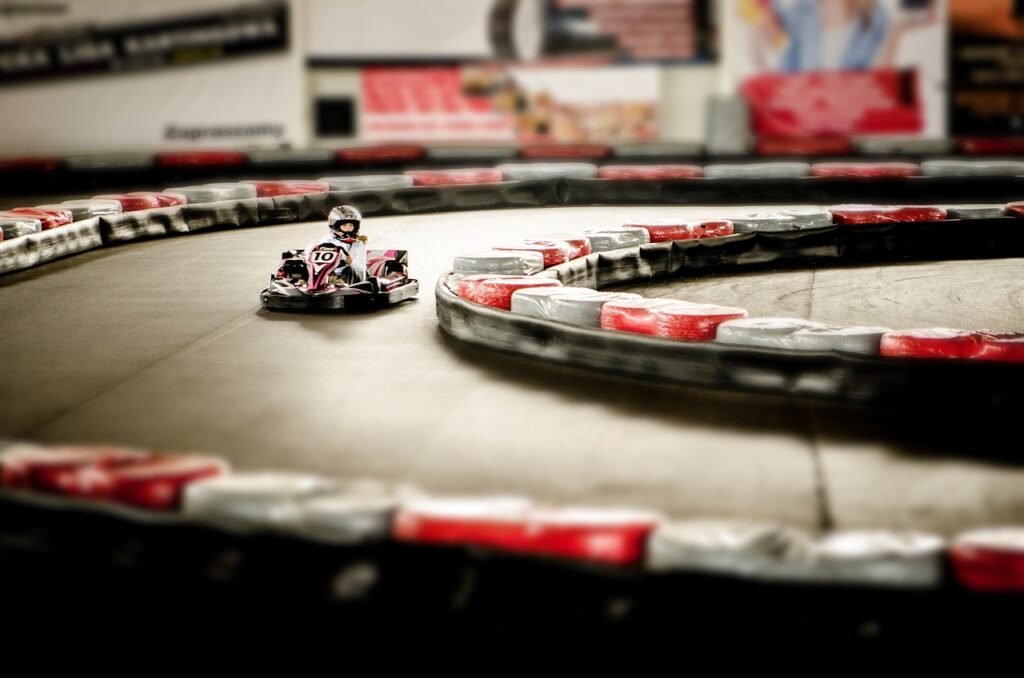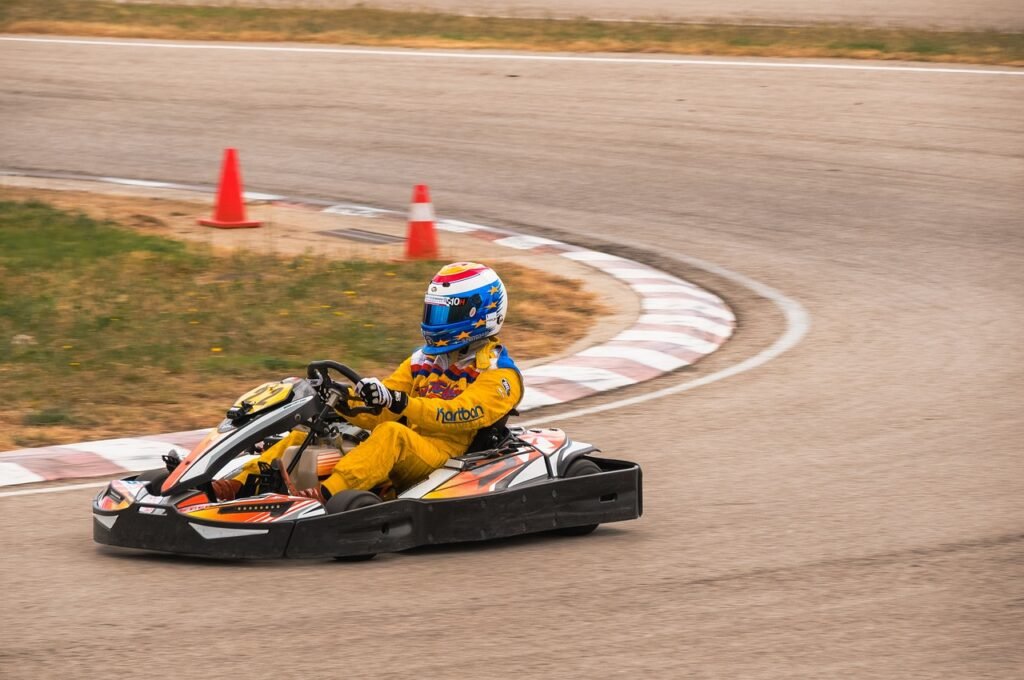At first glance, go-karts and bumper cars may seem similar—they both involve driving small vehicles in a confined space. However, the two offer vastly different experiences in terms of speed, purpose, and skill requirements.

Let’s break down the differences between go-karting and bumper cars, and what each experience offers:
1. Purpose and Objective
- Go-Karting: Go-karting is a competitive motorsport that emphasizes speed, precision, and skill. The primary goal is to race around a track as quickly as possible, often competing against other drivers or trying to beat your own best lap times. It’s focused on racing dynamics, including cornering, overtaking, and maximizing your kart’s performance.
- Bumper Cars: The main objective of bumper cars is fun and casual entertainment. Unlike go-karts, bumper cars are designed for people to bump into each other, creating a lighthearted, playful environment. Speed is limited, and there’s no concept of a race—rather, the focus is on interacting with other drivers through collisions.

Key Takeaway: Go-karting is competitive and skill-based, while bumper cars are designed for fun and social interaction.
2. Speed and Performance
- Go-Karts: Go-karts are built for speed and performance. Depending on the kart type, speeds can range from 20 mph to over 60 mph (for more advanced karts). Go-karts are designed with racing tires, powerful engines, and aerodynamic features that make them quick and responsive on a track.
- Bumper Cars: Bumper cars are intentionally slow, usually traveling at speeds between 5 to 10 mph. The focus is on safe collisions and fun rather than racing or handling performance. Bumper cars are electrically powered and have a soft, cushioned design to absorb impact from other cars.
Key Takeaway: Go-karts are designed for high speeds and performance, while bumper cars are slower and designed for safe collisions.
3. Track Design
- Go-Kart Tracks: Go-kart tracks are often purpose-built circuits with twists, turns, and straights that challenge drivers to perfect their racing lines and manage their speed through corners. The tracks are typically longer and may include safety barriers and pit stops.
- Bumper Car Arenas: Bumper car arenas are generally flat, confined areas with no specific racing layout. They are designed to encourage interaction between drivers through bumping, so the focus is on maneuverability rather than speed or cornering. The track area is often smaller and enclosed for safety.

Key Takeaway: Go-kart tracks are designed for racing, while bumper car arenas are built for safe, fun collisions in a confined space.
4. Control and Handling
- Go-Karts: Go-karts require precision and skill to handle. Drivers must learn to manage throttle control, braking, and steering to navigate tight corners at speed. Karts often have direct steering with no power assistance, which makes them challenging to control but rewarding for those looking to improve their racing skills.
- Bumper Cars: Bumper cars are designed for easy handling and safety. Steering is simple, with wide, cushioned turns to ensure safety during collisions. The controls are basic, with a simple accelerator pedal and a steering wheel, making them accessible to people of all ages, including young children.
Key Takeaway: Go-karts require skillful handling, while bumper cars offer simple, beginner-friendly controls.
5. Safety and Risk
- Go-Karting: Since go-karting involves higher speeds and more complex driving, there’s an increased level of risk compared to bumper cars. Drivers must wear helmets, and many tracks require additional safety gear like racing suits, gloves, and neck braces. Karting tracks are equipped with barriers, and instructors provide safety briefings before each session.
- Bumper Cars: Bumper cars are designed for safe collisions, with cushioned exteriors to absorb impact. The low speed and confined environment make them a very safe activity, suitable for young children and families. No helmets or specialized gear are needed, and the risk of injury is very low.
Key Takeaway: Go-karting carries a higher risk due to speed, requiring safety equipment, while bumper cars are designed for low-risk fun with minimal safety concerns.

6. Audience and Experience Level
- Go-Karting: Go-karting appeals to a wide range of audiences but is particularly suited to those looking for a competitive and adrenaline-fueled experience. It requires some degree of skill and is popular with motorsport enthusiasts, as well as people looking for a more serious racing challenge.
- Bumper Cars: Bumper cars are geared toward family fun and amusement, making them ideal for younger children, families, and groups of friends looking for a relaxed, enjoyable time. No racing skills are required, and it’s purely about having fun in a playful, safe environment.
Key Takeaway: Go-karting is for those seeking a challenging and competitive experience, while bumper cars are perfect for casual, family-friendly fun.
Go-Karting vs. Bumper Cars
Go-karting is for people who want a more serious and thrilling experience, focusing on racing skills, speed, and competition. It’s an excellent entry point into motorsports and appeals to anyone looking to improve their driving technique and experience the adrenaline of racing.
Bumper cars, on the other hand, are designed for playful, low-speed fun, making them ideal for family outings and group activities. There’s no competition—just the joy of bumping into other cars in a safe and controlled environment.
Whether you’re looking for a high-speed challenge or some lighthearted fun, both activities offer a unique and enjoyable driving experience! But if you want to try go-karting in Bangalore, Aruani Grid Motorsports Academy is the best place to be.
